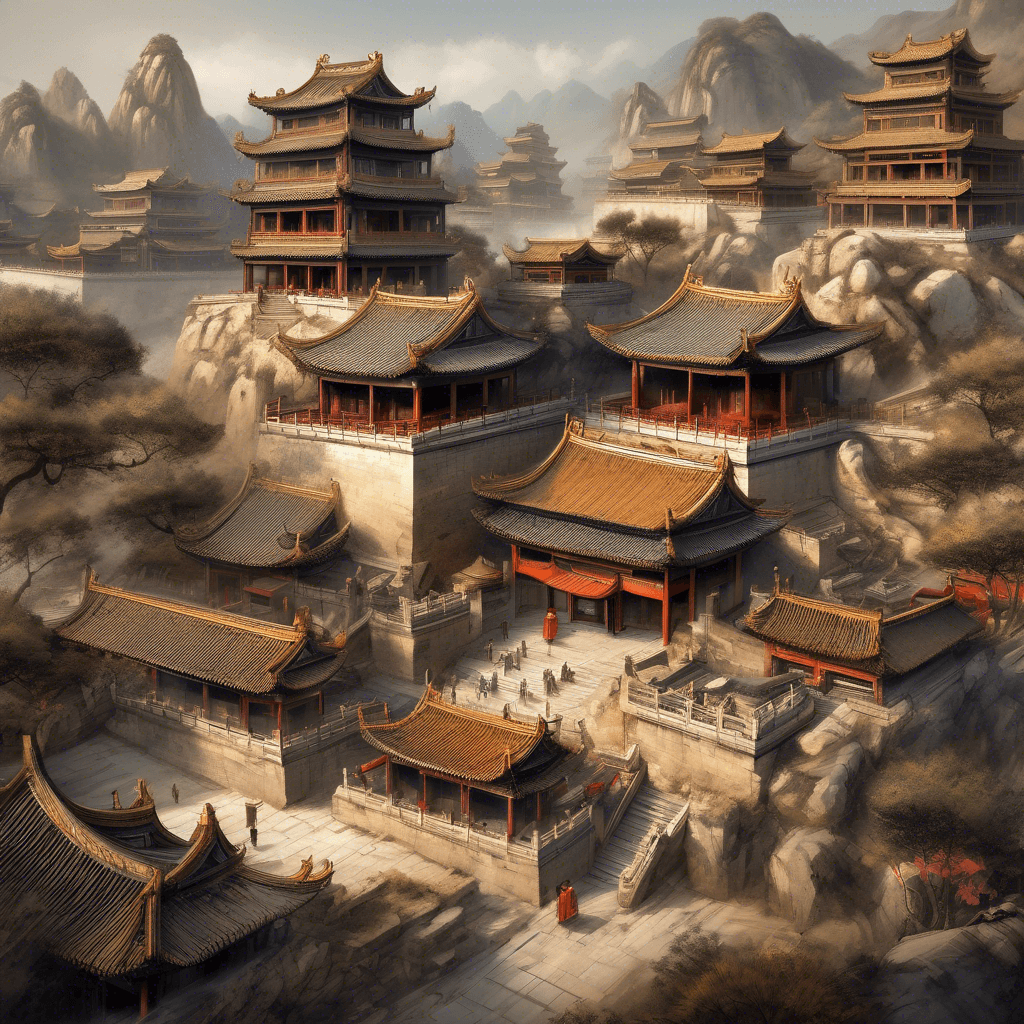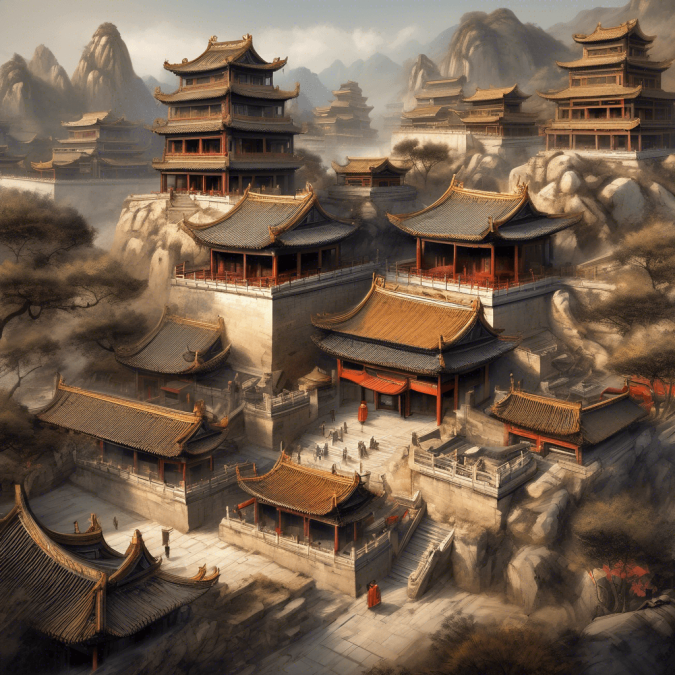
In Chinese mythology, there is a famous flood story known as the “Great Flood of Gun-Yu.” This story is found in ancient Chinese texts such as the “Classic of Mountains and Seas” (Shan Hai Jing) and the “Records of the Grand Historian” (Shi Ji) by Sima Qian.
According to the myth, the flood was caused by the deity Gong Gong, who was angry and wreaked havoc on the world. The floodwaters rose so high that they threatened to engulf the entire land. To stop the flooding and save humanity, the legendary Emperor Yao appointed his minister Gun to manage the disaster.
Gun worked tirelessly to control the flood by building channels, ditches, and dams. He directed the efforts of countless people over many years to channel the waters and save the land. Gun’s son Yu continued his father’s work and eventually succeeded in draining the floodwaters, thus earning the mandate to become the next emperor and founding the Xia dynasty.
The story of Gun and Yu’s efforts to control the Great Flood is seen as a symbol of resilience, perseverance, and the importance of working together to overcome challenges. It is also considered a foundational myth in Chinese culture, highlighting the significance of flood control and the establishment of dynastic rule in ancient China.
In the Chinese flood story of Gun-Yu, there are several key characters who play significant roles in the myth. Here are some of the main characters:
1. Gong Gong: Gong Gong is a deity in Chinese mythology who is often associated with water and is blamed for causing the Great Flood. He is depicted as a rebellious and destructive figure who brings chaos and disaster to the world.
2. Gun: Gun is a minister appointed by the legendary Emperor Yao to manage the flooding caused by Gong Gong. Gun is known for his hard work, dedication, and ingenuity in building channels and dams to control the floodwaters.
3. Yu: Yu is Gun’s son and a central figure in the flood story. After Gun passes away, Yu takes over the task of flood control and continues his father’s work. Yu is credited with successfully draining the floodwaters and earning the mandate to become the next emperor, founding the Xia dynasty.
4. Emperor Yao: Emperor Yao is a wise and legendary ruler in Chinese mythology who appoints Gun to handle the flood crisis. He is known for his moral leadership and governance, and his decision to entrust Gun with the flood control task is seen as a wise choice.
These characters embody important themes in the Chinese flood story, such as the struggle against natural disasters, the importance of hard work and perseverance, and the transition of power and leadership in the ancient world. Their actions and roles in the narrative contribute to the overall significance of the Great Flood myth in Chinese culture.
The similarities between China’s Great Flood story of Gun-Yu and the biblical tale of Noah’s Ark are striking, despite their cultural and geographical differences. Both narratives involve a catastrophic flood that threatens the survival of humanity and animals, as well as the central theme of a chosen individual or family building a vessel to preserve life. Here is an article that explores the similarities between these two flood stories:
The Great Flood: A Comparative Analysis of China’s Gun-Yu and the Biblical Noah’s Ark
Introduction
The mythological stories of China’s Gun-Yu and the biblical Noah’s Ark share remarkable similarities, despite originating from different cultural traditions. Both tales revolve around a devastating flood that tests the resilience of humanity and the necessity of divine intervention to ensure survival. This article will delve into the parallels between these two flood narratives and explore the universal themes of catastrophe, salvation, and renewal that they embody.
Similarities in Narrative Structure
In both stories, the flood is triggered by divine wrath or displeasure, leading to a global deluge that threatens to wipe out all life on Earth. In response to the impending disaster, a chosen individual or family is tasked with building a massive vessel to shelter themselves, their loved ones, and a selection of animals from the impending floodwaters. Gun and Yu in the Chinese narrative and Noah in the biblical account are depicted as righteous and obedient figures who follow divine instructions to construct their respective arks.
Themes of Cleansing and Renewal
The flood serves as a purifying force in both narratives, symbolizing a form of divine judgment that cleanses the world of corruption and sin. Through the ordeal of surviving the flood, humanity is given a chance to start anew and rebuild civilization. The ark becomes a vessel of salvation and hope, carrying the seeds of life that will repopulate the Earth after the waters recede. This theme of rebirth and renewal underscores the transformative power of the flood as a catalyst for change and regeneration.
Cultural Significance and Legacy
The stories of Gun-Yu and Noah’s Ark hold profound cultural significance in their respective traditions, serving as foundational myths that shape beliefs, values, and worldviews. While the narratives may vary in details and symbolism, they share a common message of resilience, faith, and the enduring power of human spirit in the face of adversity. The parallel themes of catastrophe, survival, and rebirth resonate across cultures and generations, highlighting the universal appeal of flood myths as potent symbols of endurance and hope.
Conclusion
In conclusion, the Great Flood stories of Gun-Yu and Noah’s Ark offer a compelling lens through which to explore the shared themes of catastrophe and salvation in different cultural contexts. Despite their distinct origins, these narratives converge on the fundamental human experiences of facing disaster, seeking refuge, and embracing the promise of renewal. By examining the similarities between these flood myths, we gain insights into the common threads that bind diverse mythological traditions and underscore the enduring relevance of these ancient tales in shaping our understanding of the human condition.
Certainly! Here are some recommended books that explore and delve deeper into the flood myths, including China’s Great Flood and Noah’s Ark:
1. “When the Rain Came: The Story of the Great Flood” by Alma Fullerton – This beautifully illustrated children’s book retells the story of the Great Flood from China’s Gun-Yu myth. It follows the journey of a young girl named Malini and her family as they face the floodwaters and work together to survive.
2. “Noah’s Ark” by Jerry Pinkney – This award-winning picture book offers a stunning visual interpretation of the biblical story of Noah’s Ark. Jerry Pinkney’s intricate illustrations bring to life the tale of Noah, the animals, and the ark in a captivating and engaging way.
3. “The Ark Before Noah: Decoding the Story of the Flood” by Irving Finkel – This non-fiction book explores the ancient Mesopotamian origins of the flood myth, drawing on the Epic of Gilgamesh and other ancient texts. Irving Finkel, a renowned expert on cuneiform tablets, provides insights into the historical context and cultural significance of flood stories.
4. “The Flood Myth” by Alan Dundes – This scholarly work examines flood myths from various cultures around the world, including China, Mesopotamia, and the Americas. Alan Dundes analyzes the common motifs and themes found in flood narratives and explores their symbolic meanings and cultural significance.
5. “The Deluge: The Great War and the Remaking of Global Order 1916-1931” by Adam Tooze – While not directly focused on ancient flood myths, this book delves into the historical impact of World War I as a “deluge” that reshaped global politics and society. Adam Tooze offers a comprehensive analysis of the aftermath of the war and its transformative effects on the world order.
These books offer a range of perspectives on flood myths, historical events, and cultural interpretations that can deepen your understanding of narratives like China’s Great Flood and Noah’s Ark. Whether you’re interested in mythology, history, or storytelling, these books provide valuable insights into the enduring significance of flood stories across different traditions and time periods.
